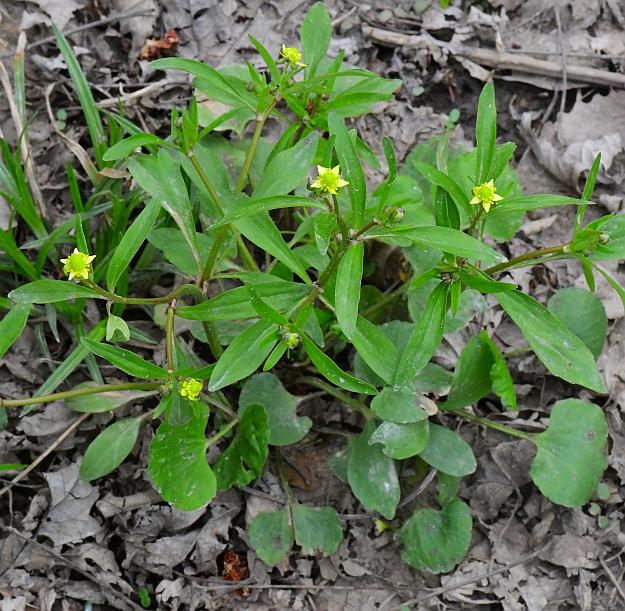Ranunculus abortivus L.
Small-Flowered Crowfoot

Native
CC = 1
CW = -3
MOC = 92
© SRTurner
Ranunculus abortivus L.Small-Flowered Crowfoot | |
 |
Native CC = 1 CW = -3 MOC = 92 |
© SRTurner |
|
Family - Ranunculaceae Habit - Biennial or short-lived perennial forb. Roots not tuberous (but sometimes enlarged basally).
Stems - Ascending to erect, to 70 cm, not rooting at the lower nodes, multiple from base, branching, glabrous, glabrous, without bulbils, the base not bulbous-thickened.
Leaves - Basal leaves present at flowering, moderately to long-petiolate, the blade 1-4 cm long, 2-5 cm wide, kidney-shaped to more or less circular, simple, unlobed or sometimes the innermost 3-lobed, the base shallowly to deeply cordate, the margins scalloped. Stem leaves sessile to short-petiolate, the blade deeply 3-or 5-lobed or -compound, the segments narrowly lanceolate to obovate, the broader ones toothed or narrowly lobed along the margins.
Inflorescence - Open panicles or single flowers at branch tips. Peduncle to 9 cm long, glabrous.
Flowers - Sepals 5, 2.0-2.5 mm long, spreading or reflexed from the base with age, lacking a transverse fold, plane. Petals 5, 1.5-3.5 mm long, 1-2 mm wide, elliptic, slightly shorter than the sepals, yellow, glabrous. Stamens 20 or more, from base of pistils. Filaments and anthers yellow. Pistils numerous, forming a globose head to 5 mm long. Style present but minute.
Fruits - Head of achenes 3-6 mm long at maturity, ovoid-globose, the receptacle sparsely hairy. Achenes 1.4-1.6 mm long, turgid, the dorsal margin broadly and bluntly angled, the wall thick, smooth, glabrous, the beak 0.1-0.2 mm long, slender, curved.
Flowering - March - June. Habitat - Streambanks, pond margins, forests, prairies, ledges of bluffs, pastures, fields, orchards, lawns, ditches, roadsides, and open, disturbed areas. Origin - Native to the U.S. Lookalikes - Other species of Ranunculus, especially R. micranthus. Other info. - This is a very common plant throughout Missouri, also ocurring across most of the continental U.S. except for a few western states. It is easily recognized by its small, pale yellow flowers, basal leaves, and generally sparse habit. It strongly resembles R. micranthus but can be distinguished from that species by its glabrous stems and basal leaves with cordate bases. It is also somewhat weedier than R. micranthus, occurring in lawns and pastures in addition to less disturbed habitats. It tends to prefer areas of abundant moisture. Photographs taken off Northwood Rd, Platte County, MO., 3-28-00, in Brown Summit, NC., 3-14-03, and off Lee Rd 54, Auburn, AL., 3-3-05 (DETenaglia); also near Labadie, Franklin County, MO, 4-23-2014, Pacific Palisades Conservation Area, Jefferson County, MO, 4-2-2019, near Labadie, Franklin County, MO, 4-1-2020, Young Conservation Area, Jefferson County, MO, 3-30-2021, and along the Katy Trail near Dutzow, Warren County, MO, 4-18-2022 (SRTurner). |